59 Smart and Stylish Small Hallway Solutions for a Functional Home
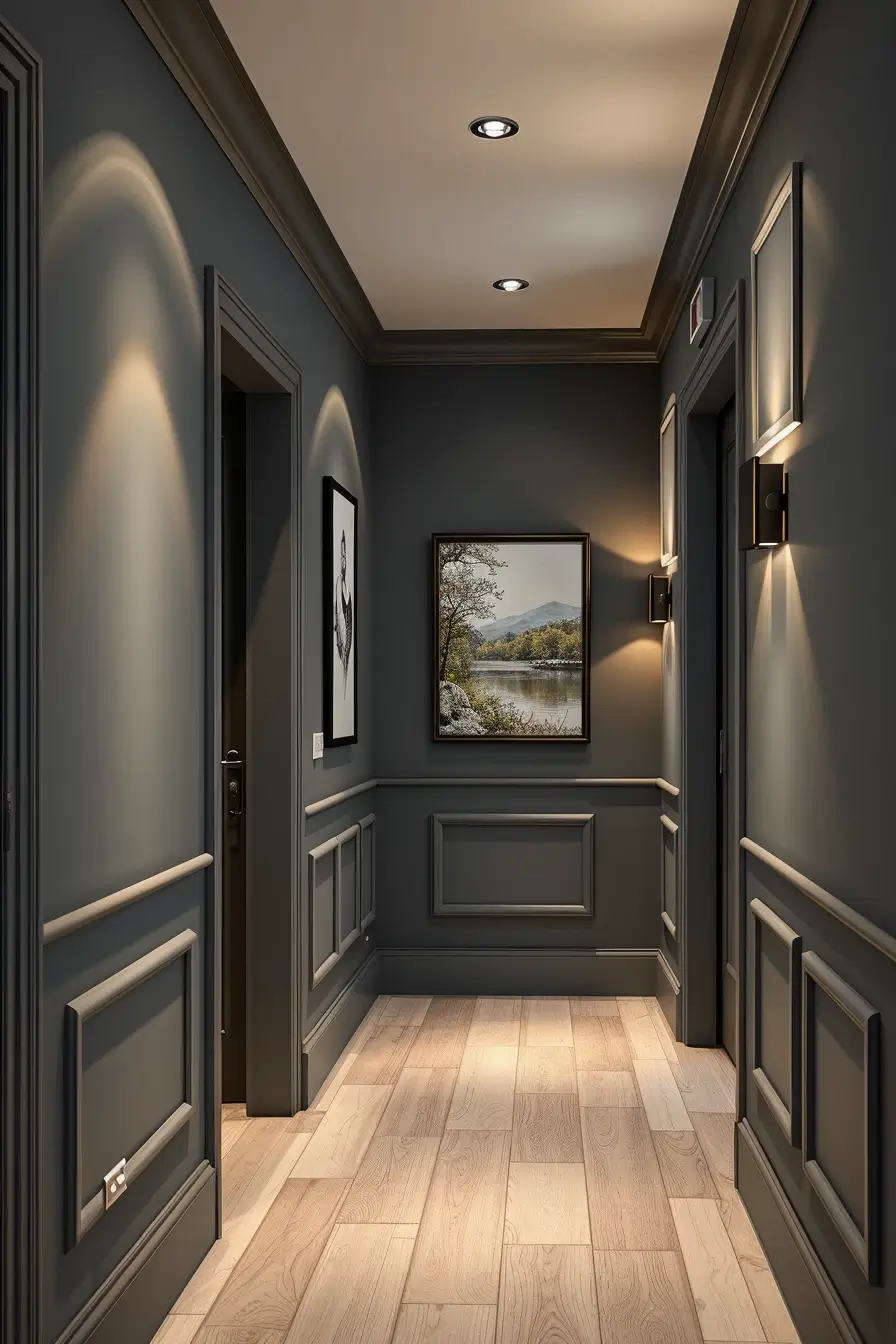
Does your hallway seem too small to make the most of? Would you like your tight passageway to feel bigger, look better and be more useful? In the following, I will suggest simple yet useful small hallway fixes that can make a real difference using little space. Every suggestion is meant to make your hallway look better with a maximized layout, improved lighting and a simpler, coordinating color scheme. No matter if you’re redecorating a little or making bigger changes, these ideas will give your entry a fresh appearance.
Maximize Every Inch With Slim Storage Units
The goal in any small hallway is to use as much space as possible—with a special focus on the floor. With little space, I look for skinny storage options that don’t disturb the path through the corridor. The type of unit works for you—store-bought or custom—and the most important feature is a slim width so the unit doesn’t take up too much space.

Most of the time, I prefer to buy units that are mostly vertical with drawers or shelves positioned high or low, like shoe cabinets or skinny lockers. Shutting a closet keeps your things tidy, but leaving your cubbies open makes it easy to get at the things you use daily. Slim cabinets can also serve as a home for Wi-Fi routers and umbrellas. Make sure your furniture helps you store items orderly and creates a visually open look.

When you have kids or pets around, slim storage is such a great idea. I put a Besta unit from IKEA in a hallway for a client and it helped them keep seasonal shoes and leashes organized. According to Apartment Therapy, putting up narrow, closed-compartment furniture is a great way to make a small place more peaceful.
This part could be made even better by adding a basket system inside the lower cabinet for gloves, hats or keys. It can quickly improve the way you work and lower the risk of disorder.
Use Vertical Space With Tall Cabinets And Hooks
Tall vertical pieces make my design plans extra special when working around hallways. The lack of floor area means that walls should be used for extra functions. I found that higher cabinets or coat trees and even tall wardrobes, help draw the eye up and make the overall room feel more spacious. Hooks, arranged at various levels, make it simple to keep what you use most accessible.
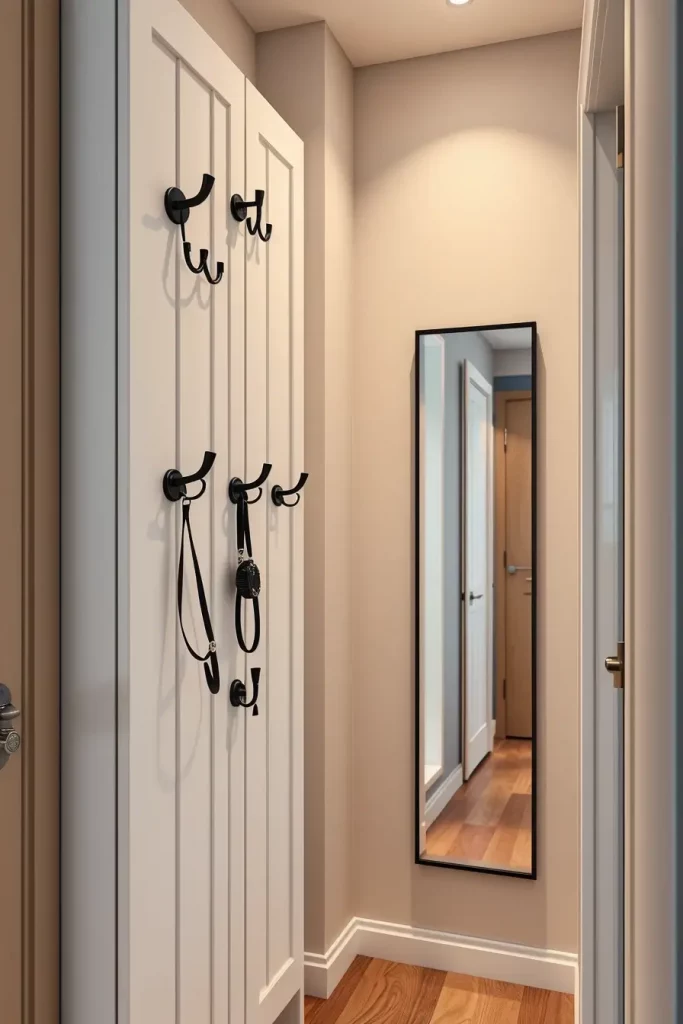
For styling, a tall cabinet above images with rows of wall-mounted hooks below looks good. People with lots of accessories will find this works great to keep things organized. If you want your hooks to look pretty, try using brass, matte black or wood-colored pegs to blend with your hallway. If you’d like, put in a slim mirror panel beside the cabinet to use it for storing and viewing yourself at the same time.
I’ve found that using tall storage leads to a less messy daily environment. I remodeled a hall with hooks at both grown-up and child eye levels which improved the order at the entryway. The Spruce points out that using vertical storage attracts your sight to the ceiling which frees up space along the bottom.
Another way to make this work better is to add a shelf above the hooks for storing baskets or decor. It focuses your eyes up and creates extra room for you.
Add A Mirror Wall To Expand Visual Space
Adding mirrors to a small hallway is the easiest way I know to make it look wider. Having a mirror wall, no matter the style, helps make the room feel larger by reflecting its architecture and the light scattered through the room. It lights up regionally dark areas and gives your home a pleasant and stylish atmosphere when you do it right.

Floor-length or horizontal mirrors—depending on the porch’s layout—are typically what I use. If I’m going for creativity, I sometimes group mirrors in frames of the same design to form a gallery installation. Make sure the frames complement the color of your wall or try and contrast them for different effects. I suggest putting the mirror where it will get the best reflection from nearby lights.
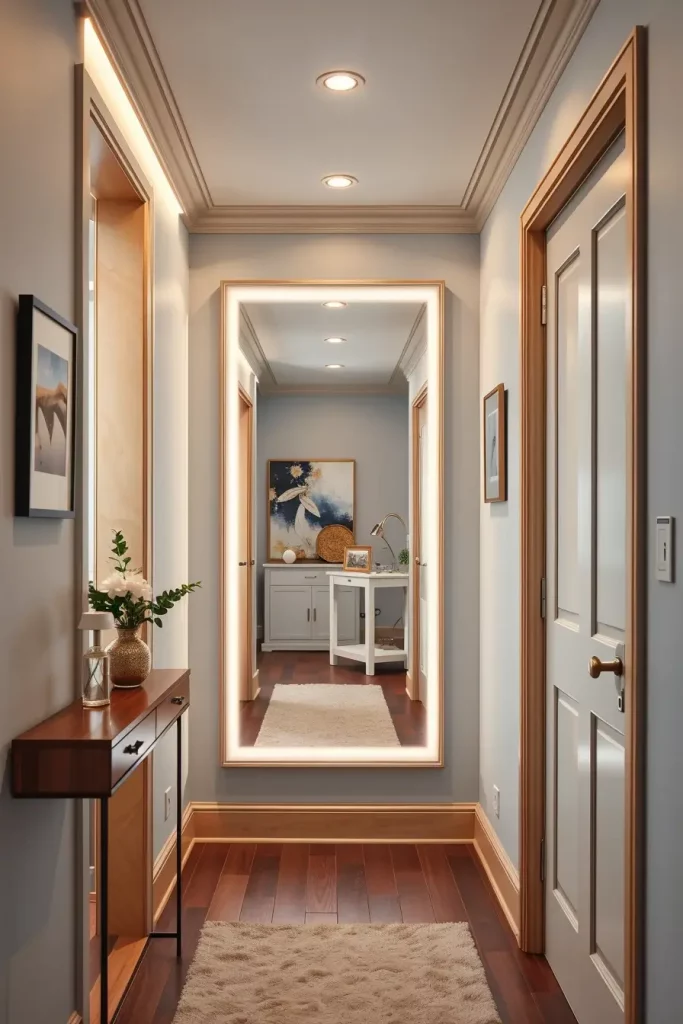
A big mirror in my hallway makes the entrance seem larger and gives me an easy check before going out. Elle Decor points out that if you have a tight space, a mirror will make it feel more open and soothe sharp edges in your architecture.
For a better effect, placing a small sconce or LED strip to the border of the mirror will create more light on it.
Brighten The Space With Strategic Lighting
Lighting is one of the biggest issues you’ll find in many small hallways. If there isn’t enough natural light, the spaces can be tight and dim. It’s important for me to highlight any bright spaces and set up lighting to make the corridor feel more inviting. You should have overhead lights, sconces built into the walls and floor-level LEDs.

I find that flush-mounted ceiling lights and slim track lighting create a modern style. They light up the entire hallway without taking up space. They are great for highlighting your home or artwork and for adding more warmth to your surroundings. Putting LED strip lights below a console or shelf in the hallway gives a nice touch of light to the lower parts.
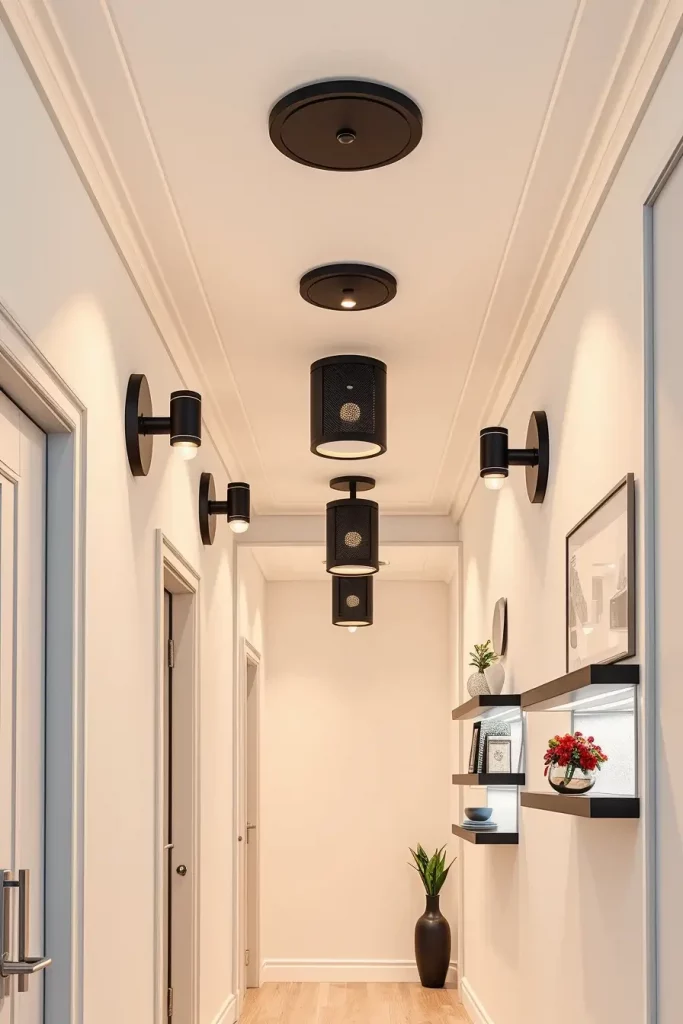
Together, we put in motion-sensor lights in the hallway of their home and the lights would come on automatically after sundown—a very helpful and economical design. According to House Beautiful, “hallway lighting should lead the eye and complement the room’s function.”
Another thing I’d suggest is adding a small, indirect light such as a tall lamp on a shelf.
Choose Light Colors To Open Up The Hall
The color you pick for a small hallway is key and I often choose shades that brighten the space. White, pale gray and light beige colors attract more light and help the space look larger. This instantly helps an average hallway appear more open.

When I work on a project, I like to use walls finished in matte or eggshell, with white trim and baseboards to make them stand out. If you want your room to seem more balanced, try using a gentle transition from the floor to the ceiling. Dark flooring designs should be avoided, as pale wood or light tiles work perfectly for connecting the spaces. You can add a modern touch with pale sage or powder blue used in your home’s art and accessories.
I’ve found that painting a dark corridor white changed it from a lonely hallway into a welcoming room in the house. It is said by Better Homes & Gardens that the color you choose for your home will determine if your small space will feel stuck or open.
To make the whole concept work, I’d also place a light-colored rug across the entire length of the hall for even more softness and matching.
Install Floating Shelves For Functional Decor
Bringing decor into a small hallway without losing space works best for me with floating shelves. Being mounted on the wall allows them not to take up room in the middle of the space and when planned well, they can act both as shelves and as a place to hang artwork. They make the space seem brighter, especially when the shelves are made from light woods or acrylic or glass.

For most looks, I put two or three shelves at different heights so everything is even. These can function as key and wallet holders or as a place to put framed art, candles and growing plants. Be sure to arrange everything evenly so the hallway doesn’t seem cramped. Evenly spacing shelves at eye height should make your room more put together and modern.
It was the thin hall in a client’s home that I added floating walnut shelves to and it quickly turned into their favorite place to show off their things. Floating storage gives small areas room to breathe without losing function, according to Real Simple.
I would go one step further and install a little charging dock or key holder beneath one shelf for those living in a busy home.
Create A Drop Zone With Wall-Mounted Racks
Almost all small hallways should have some sort of functional “drop zone” to drop or hang your daily items. I like hanging racks that stay on the wall, since they both keep items off the floor and make the wall look neater. These racks often come with trays, hooks or slots for storing mail and sunglasses, so they’re most helpful near the entrance.

Instead of regular shelves, I choose racks that have space for hangers, places for shoes and a bit of room above for some nice decor. Many interiors look good with either black metal or warm wood finishes. Should the area permit, I suggest putting a mirror or bulletin board along with the rack to maximize how the area is used. It’s important to choose a setup that makes your daily tasks easier without making things look messy.
I really liked one of my drop zones that featured a rack of reclaimed wood, black iron hooks and a little letter tray. HGTV experts suggest that the area by your front door should be simple to organize and motivate you to stay neat from day one.
I think adding a hanging plant or a tiny art object to the wall would bring more character to the area and make it look more fully planned.
Use Narrow Console Tables With Hidden Drawers
When you want to use your space wisely in a small hallway, adding a console table that includes hidden storage is incredibly helpful. With such pieces, you have extra storage for everyday items or decorations without hampering the area’s flow. Having these hidden sections allows you to neatly store keys, mail or regular carry items, leaving the surface free of clutter.

Usually, I go with table depths between 10 and 12 inches based on the hallway’s width. For a cleaner look, models with smooth drawer fronts hide your items out of plain sight. An easy way to add personality to the top is with a small vase, lamp or tray. Materials like oak, walnut, or lacquered finishes work well depending on the home’s overall style. A console looks better when it’s matched with a mirror or a framed piece of artwork overhead.

A narrow black console with brass handles that I put in my hallway greatly transformed the space. It’s great that this kind of storage doesn’t overcrowd where it is placed. According to Domino magazine, narrow entry tables help catch items and look great as well.
Even so, I would place a handy stool or ottoman below the console for comfortable seating. The storage stool is easy to use and can be tucked away quickly.
Make Use Of Corners With Custom Shelving
Most people don’t use the space at corners in narrow hallways, but I recommend filling these areas with well-designed storage shelves. Shelves placed wherever there’s space, floating or on the ground, are the right solution for using awkward areas and adding character to your décor. You can use corner shelves for decor and for storage.
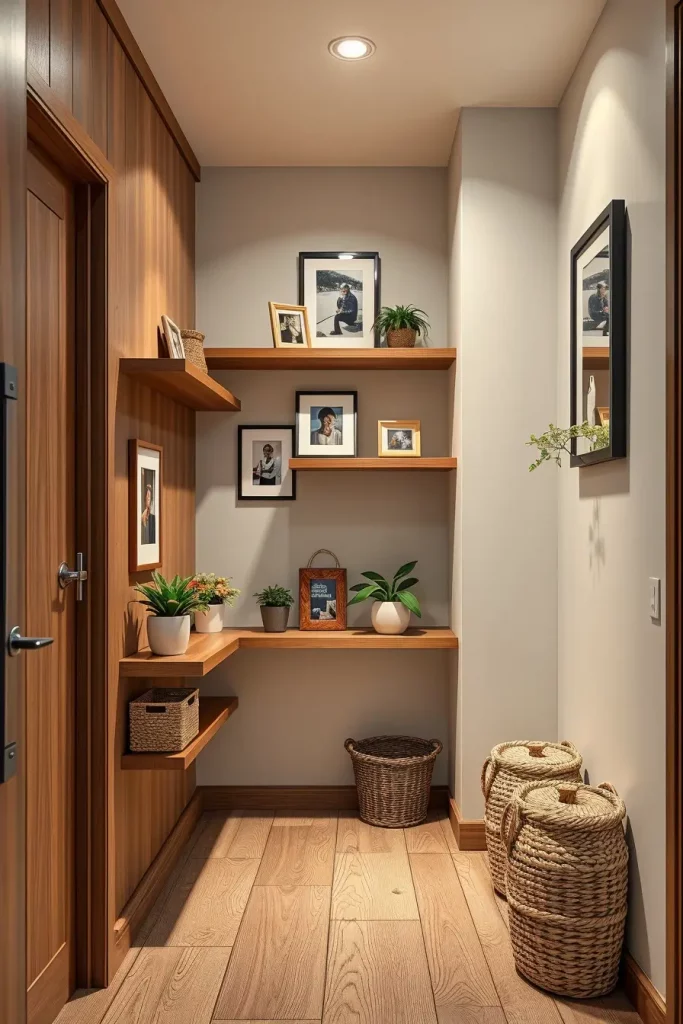
What I find useful are L-shaped floating shelves or tall triangles that can rest firmly where two walls meet. I put books, framed photos or small potted plants down inside them. Open shelves made of wood look bright and inviting and painted MDF shelves fit right into your wall color. You can make use of small drawers or baskets to give your storage a bit more organization.
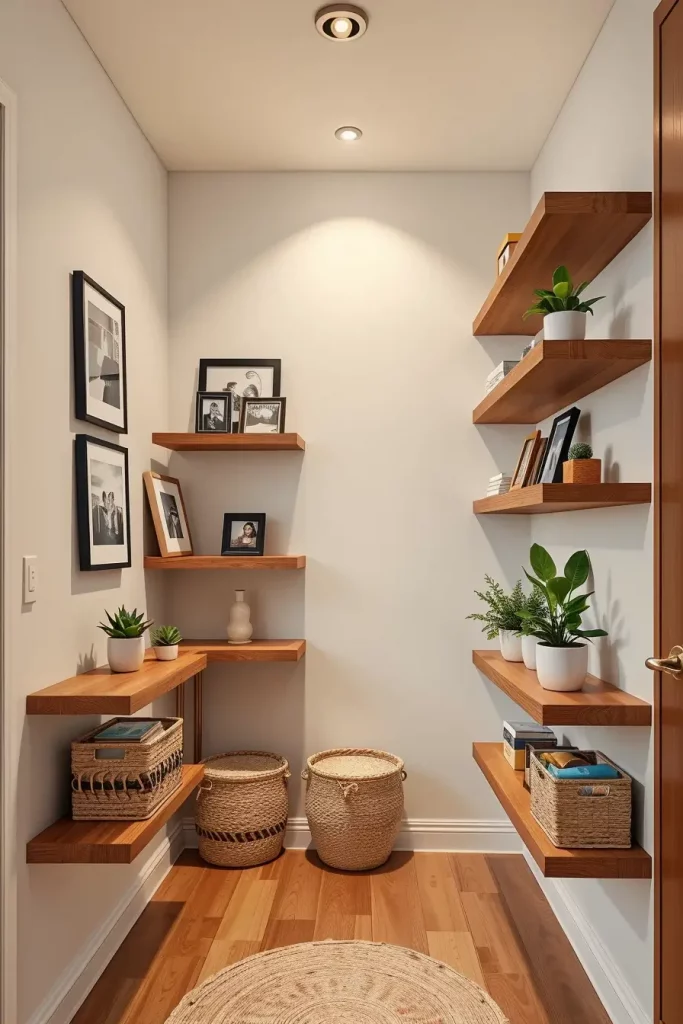
We recently installed shelves in the corner above eye level so the shelves don’t take up floor area. It turned out wonderfully. As explained by Martha Stewart Living, corner shelves make unused details in a room into attractive places to put things.
To build a truly impressive desk, I recommend putting lights beneath the bottom shelf. It showcases the area and brings a bit of refined style.
Design A Mini Gallery Wall For Personality
Even the tiniest hallways are great for expressing your personal taste, with a quick gallery wall display. Using it in narrow areas gives a less clinical feel to everything. Putting up framed photos, artwork or a curated collection turns the space into a space that feels expressive and fit for guests.
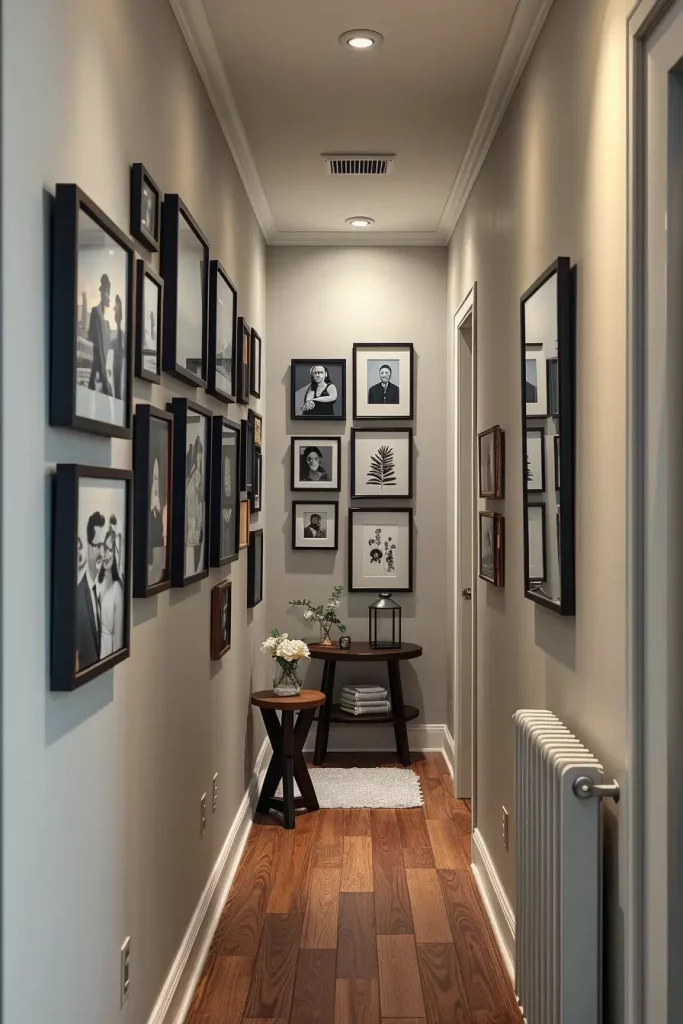
I like to go with small frames instead of large ones so the wall decor doesn’t feel too busy. I recommend making your first marks in the middle and then working them out to the top, following a grid or offset design. When a room is little, using light artwork or black-and-white pictures usually makes it feel more open. For the pieces to work together, I use matching or complementary colors in their mattes.
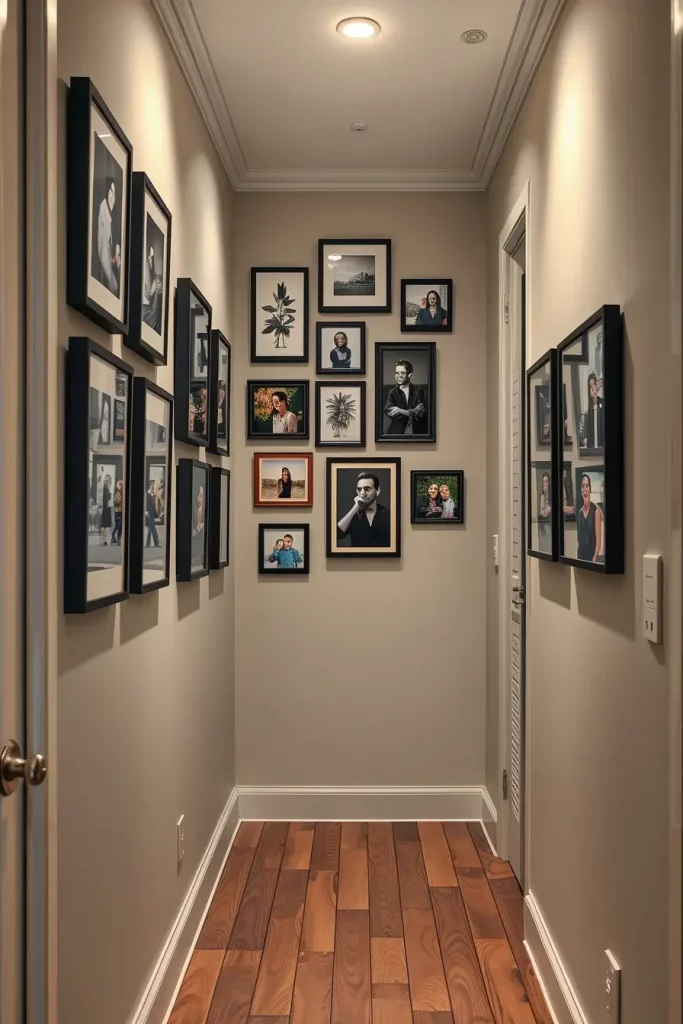
In the last design project I completed, I arranged a six-piece gallery wall in a family’s house from prints and travel photos. The hall felt more pleasant as soon as the wall was painted. According to Architectural Digest, gallery walls can add personality to places that often don’t get much attention.
You might also add a quote print or monogram art to give the display a unique and meaningful appearance.
Add A Runner Rug To Guide The Eye
Putting a runner rug in your hallway is an easy way to add shine to the space. Wood’s softness and warmth help and its design serves to draw your gaze toward the back of the corridor. Putting a chosen runner helps cozy up your space and finishes the design process.

I usually suggest using low-pile rugs in hallways to make them safer. Vertical stripes make the space seem taller, but keeping it light keeps it seeming roomier. If your home sees a lot of action, use materials like natural fibers or those safe for the machine. Placing non-slip pads beneath it is the method I use to avoid it moving.
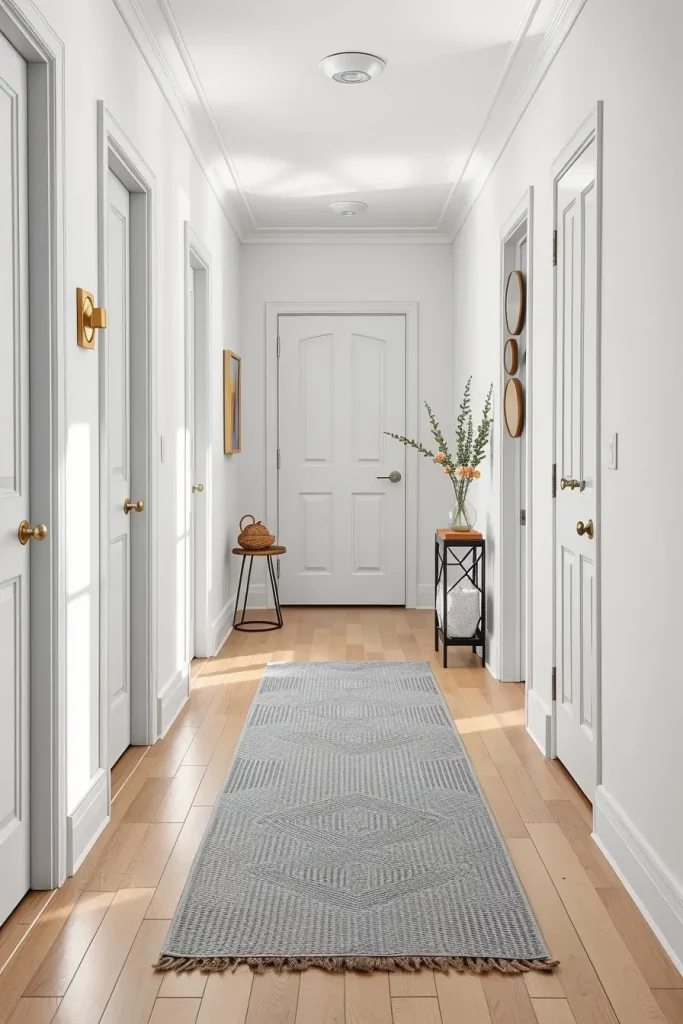
The woven runner in my hallway is soft gray with very light ivory stripes and guests always notice it. According to Real Simple, a hallway runner rug that matches the room’s design can help pull the whole area together.
I recommend also setting a matching floor mat by the entrance to keep everything coordinated.
Use Pocket Doors To Save On Swing Space
Pocket doors are often ignored as a helpful tool for hallway design in small homes. Traffic areas with typical doors are often crowded, as the open door adds to the obstacle. Alternatively, the entire wall surface can be used when pocket doors disappear into a niche within the wall. I usually turn to this solution when I need to go from one hallway to an adjacent room.

If you are picking pocket doors, opt for simple, uncluttered panels in colors that resemble the trim in your hallway. You can have light in your home while keeping your privacy with frosted glass inserts. Such doors are suitable for use in bathrooms, laundry rooms or pantries alongside a narrow hallway. They’re also great for creating open flow in studio apartments or small homes.
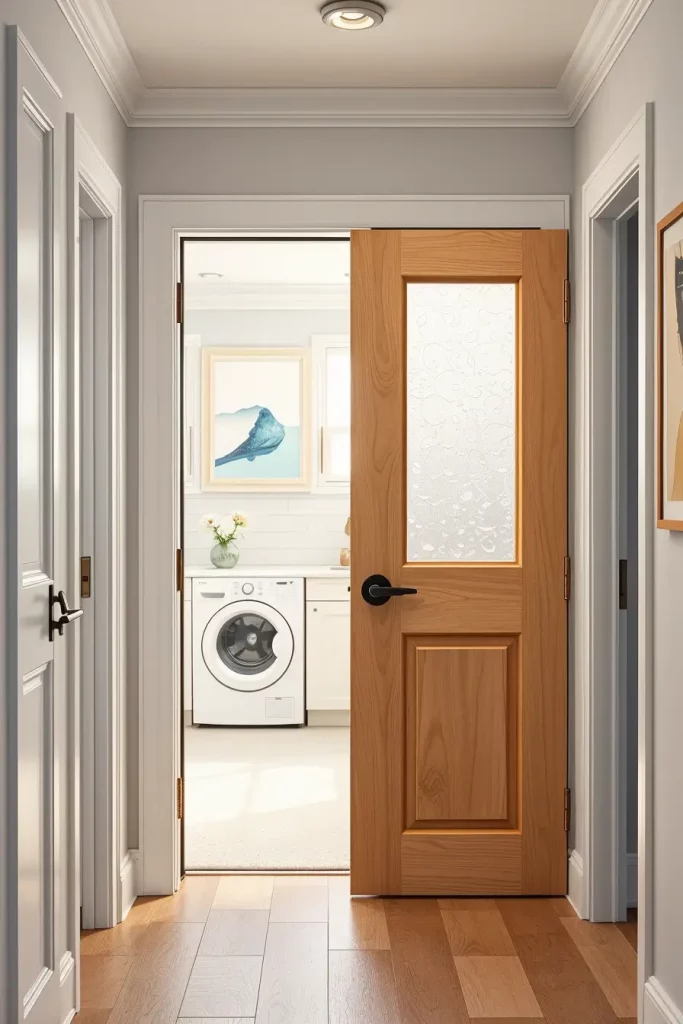
Last year, I replaced a laundry room door with a soft-close pocket model and it immediately stretched the width of the door. Dwell states that pocket doors give you more space while maintaining privacy and good looks.
Finish up the design by choosing a handle or pull that is set into or hidden in the door panel.
Choose Multi-Use Furniture Like Bench Storage
When there isn’t much space, I prefer furniture that can be used for different purposes and having a bench with storage comes first for me. This piece brings together storage and a space for sitting which is both neat and attractive. Garage-hallway combinations become more valuable along hallways that are close to the door to the outside.

I most often opt for benches with flip-up seats or drawers underneath the wooden benches. You can use these spots for your shoes, handbags or things you need for each season. If I only have a small space, I choose a backless bench that sits right against the wall. Adding cushions or throw pillows puts an inviting soft look on your bench.
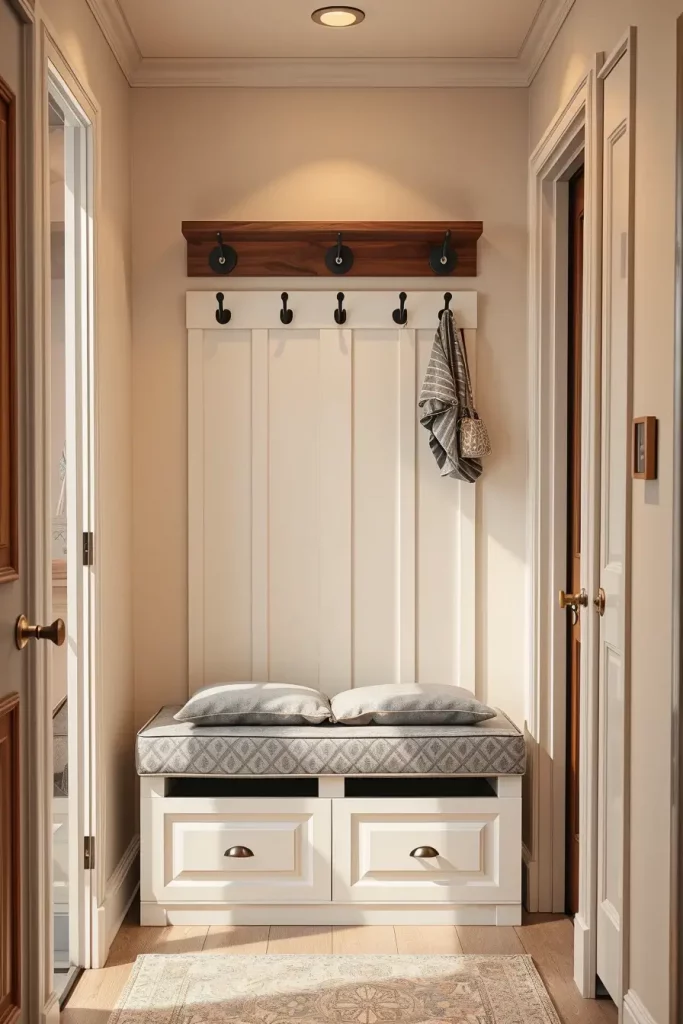
A home I styled included a white bench under a set of hooks and the family appreciated how this made their mornings more organized. Better Homes & Gardens explains that functional furniture helps you organize your entry and makes smaller spaces more appealing.
I’d like to suggest putting a wall shelf or cubby up over the bench, sourced from the same materials as the bench itself, to maximize how much you can store.
Decorate With Monochrome Color Schemes
I usually keep small hallways looking nice by using a similar color scheme throughout. If you use a basic gray or beige color on your walls, you can build on the texture without giving the room a busy feel. Using this approach makes a room feel bigger and more connected.

Picking one main color and adding shades to your walls, floors and furniture is a good idea. If you put pale gray walls, medium-gray couch cushions and charcoal artworks side by side, the result is harmony. Interesting accents such as lightning fixtures or glass vases won’t clash with your theme. The use of matte paint, brushed metal and soft fabric keeps everything visually exciting.

Clients I’ve worked for have often said that monochrome hallways give them a calm and classy vibe. Limiting the amount of colors you use in close quarters suggests Emily Henderson, helping the area stay unified and relaxed.
I’d suggest choosing just one striking item such as in navy or forest green, to help direct attention and maintain harmony within the mix.
Incorporate Glass Elements For Openness
Adding glass to a tight or small hallway is an excellent way to make it appear larger and let more light through. I usually begin with glass doors that have frosting—they preserve your privacy, but still let in plenty of light. Adding glass to your hallway close to the living room or a set of stairs can open up the area and connect different parts of your home.
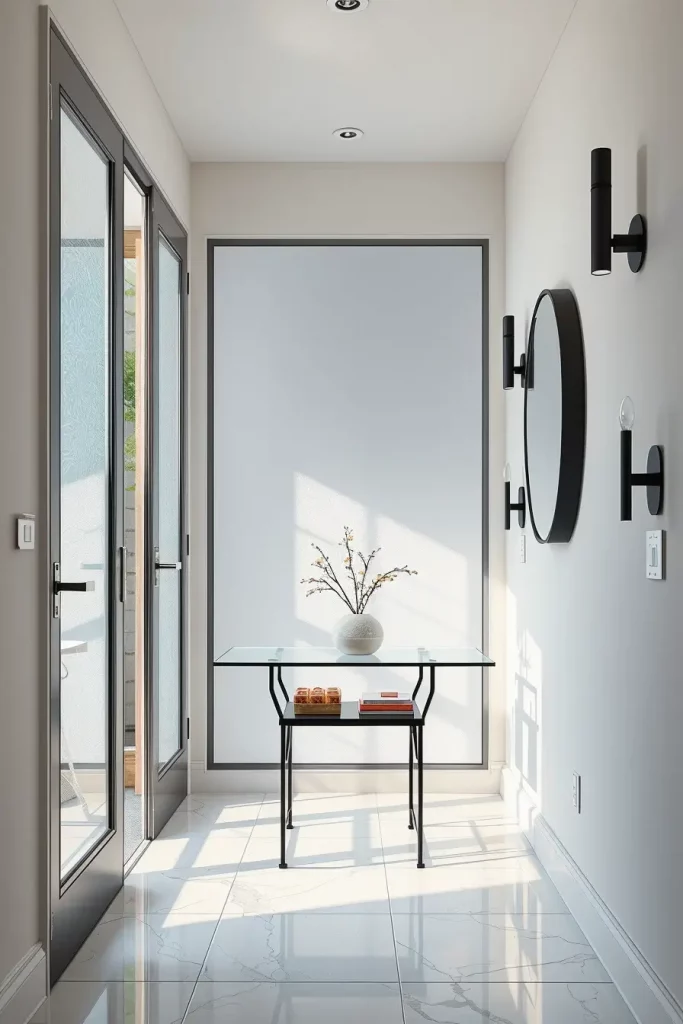
I think a nice glass console table goes well with this design. It doesn’t stand out visually and doesn’t need to add bulk to the area. Match this with a frameless glass mirror along with glass wall sconces. If a hallway adjoins a room, use a half-glass partition to let in daylight. Going for black or gold minimal frames helps your pictures look fresh and clean.
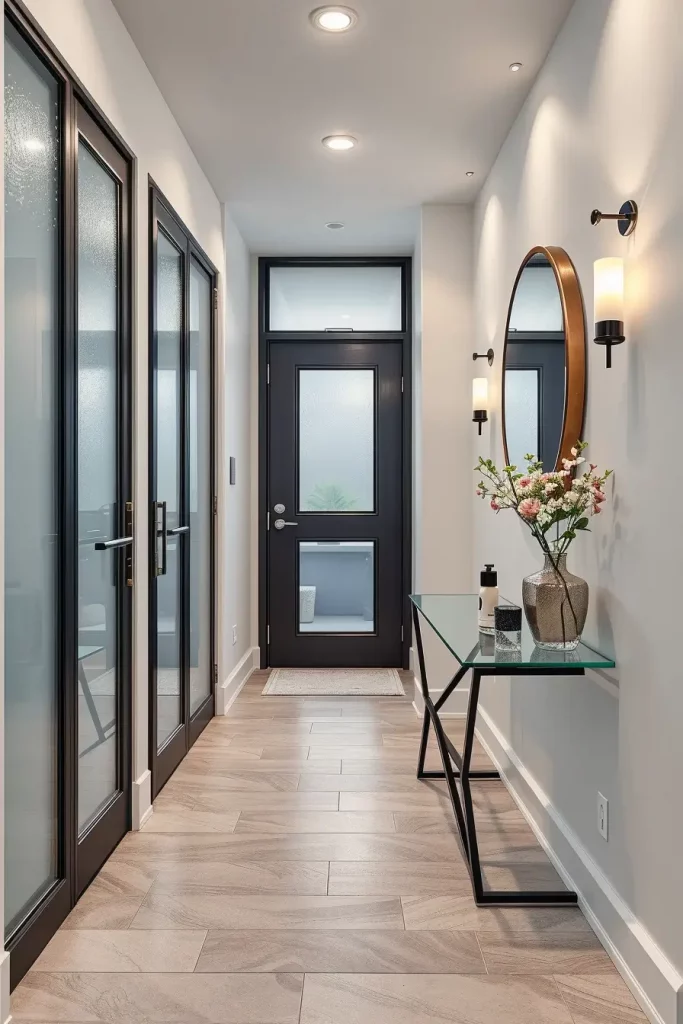
I have personally suggested this idea to apartment and townhouse customers and they see results right away. Glass is highlighted by Architectural Digest for reflecting light and adding modern chic to a smaller home. Even a single frosted glass door in a hallway can help it look much bigger.
You could even try using glass floors or ceilings in the section where possible—though they are uncommon, they really brighten up any modern small hall.
Hang Vertical Panels Or Striped Wallpaper
Vertical features guide the viewers’ gaze up which helps any narrow space appear more open and exciting. Whether you use wood or wallpaper, panels or stripes are unique ways to add height without taking away from the width of the room.

Using soft dove gray or beige striped wallpaper that goes from the floor to ceiling gives the best results. Wood strips in oak or ash inserted vertically can give your house an appealing and natural touch. Using a slender bench with a floating shelf helps you save floor area. When you can, put in a linear pendant light to add to the vertical motif.
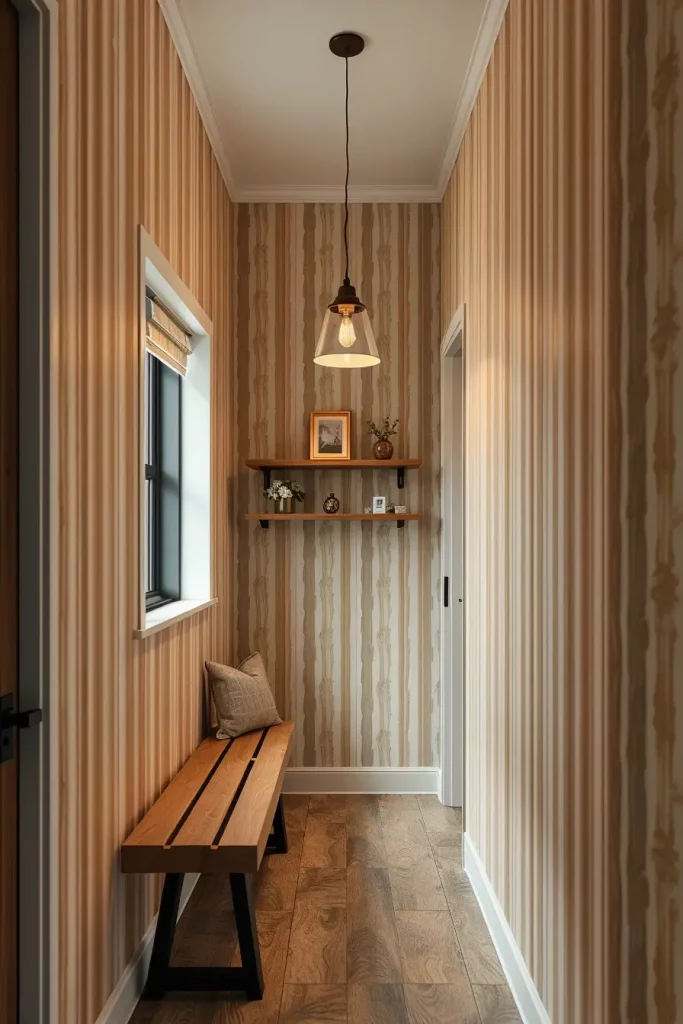
I have applied this strategy in houses that are older and don’t have a lot of natural light. Better Homes & Gardens has pointed out that vertical elements in a room create contrast and give any space instant architecture. I turn to this trick when a hallway doesn’t have enough visual appeal.
If you want to enhance the room, use vertical elements such as ribbed wainscoting or place narrow acoustic panels where sound control matters.
Use Hooks With Personality For Practical Flair
Many hallways don’t have hooks, when they should because they are very useful for keeping things orderly. I choose decorative hooks over simple metal ones, since they serve both a purpose and are beautiful. Adding a chair is an easy way to make any small hallway both prettier and more functional.

Most of the time, I go for matte black or brass leaf-shaped, animal-shaped or geometric hooks for my doors. Place mounted cabs along an interesting wall above a minimal bench or secure them straight onto a slim piece of wood. Group the seats together so people can use them at different heights. A woven basket or crate underneath will allow you to store your shoes and umbrellas.
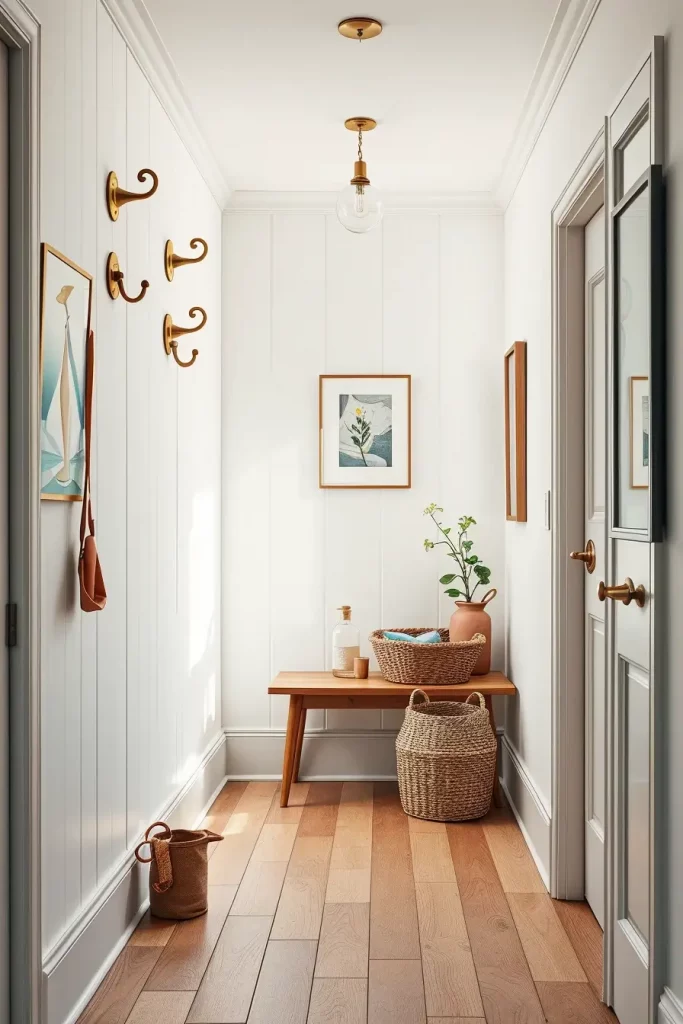
Many clients love that this small step changes daily mess into a beautifully presented showcase. Real Simple suggests that using organizational tools in these entry and transitional spaces adds style to your home.
Another idea is to put different seasonal pieces on the hooks, so your hallway can become a little highlight every season.
Go Minimal With Built-In Storage Walls
If you want to save space, in-wall storage is a wise idea for your small hallway. This way of organizing is worth recommending in places where-inch counts. By using custom millwork, it’s possible for the storage wall to blend seamlessly, so the hallway looks neat and tidy.
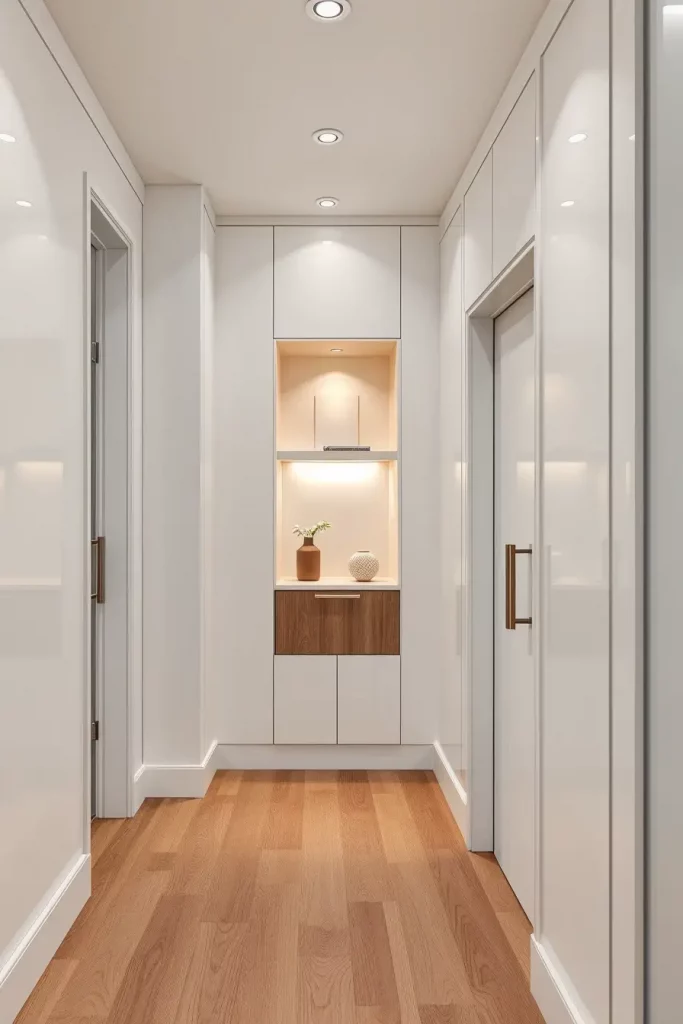
I suggest selecting a wall unit no thicker than 10 inches, with press-to-open fronts on each cabinet. Finish your room with a smooth white paint or light-coloured wood to stay on-trend. Set up a small, well-lit niche in the area for putting your keys or some fresh flowers. Cover the top with slim overhead cubbies designed for storing hats and gloves.
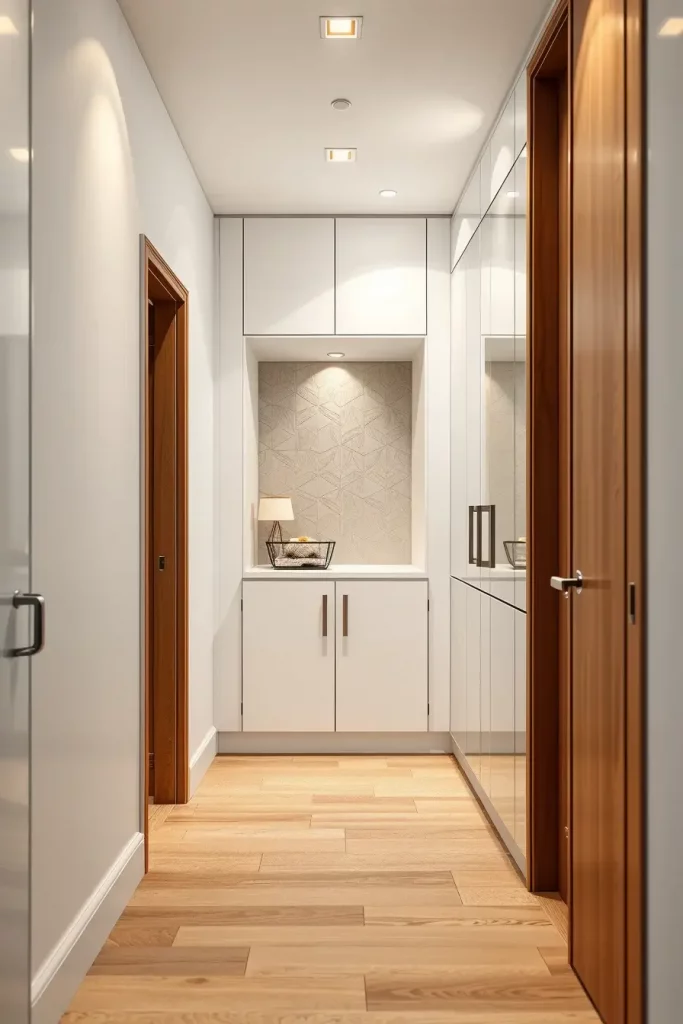
As a result, long and narrow hallways in a lot of my projects now use space more effectively. Experts from Dwell say that hiding storage vertically in hallways is a great option for saving space in tiny dwellings.
If your hallway has the space, try to fit some underfloor drawers—or consider putting in a slim, tall cabinet for storing umbrellas and similar products.
Customize With Modular Entryway Systems
Those who rent or like to change their furniture a lot will find modular entry systems perfect. With these custom units, you’ll find hooks, shoe racks and a bench for seating in one small area. I suggest them for narrow hallways when being both flexible and functional is important.

Use a set where the items are easily swapped—a narrow console table, a cushioned bench for storing things and a vertical pegboard with baskets. Try using oak or matte white as your main finish. Either place them on the wall or just display them however you like. An included fold-out tray or clip-on mirror adds helpful versatility to your bag.

I’ve assisted clients with setting up these systems in lofts, studios and the entry alcoves of their homes. They admire how easy it is to change from one task to another. According to Apartment Therapy, modular furniture is one of the best ways to organize a small space and make your hallway more modern.
In addition, I’d suggest adding smart home features: motion sensors for lights, invisible places for storing cables and devices or magnetic bars for holding keys or tools are extra ways these systems could be practical.
Make A Statement With A Bold Entry Light
How you light a hallway can make a big difference in its atmosphere. If people want a different touch, I suggest installing a sculptural pendant or wall light that also D Blueala adds to the look. It gives the room some stylish detail and brighter lighting.

Installing black, brass or smoked glass oversized pendant lights is one of my favorite ways to add lighting. Have long hallways shaped like straight lines and let short spaces be formed in a curve. Give a touch of lights to your home by lining the ceiling or baseboards with LED strips. Select warm white light to help your space feel inviting.

The same approach made a huge difference in a local townhouse: a brass chandelier turned the room from just useful to truly beautiful and planned. Minimalist design in compact areas can be reinforced by investing in at least a single sculptural light, according to Elle Decor designers.
After that, consider trying smart bulbs that automatically change colors to match the hours or mood of any given time or season. Such details are responsible for a significant change.
Install Reflective Materials To Bounce Light
Using reflective materials is a simple way to give a hall a sense of space and light. You don’t need many reflective or colorful surfaces to lighten your room and create a feeling of space.

In most cases, I suggest using mirrors, smooth metal and glassy paint. If you choose a mirrored console table, a shiny ceiling or wallpaper with metal accents for one half of the hallway, you’ll have a gracious entrance. In addition, chrome or brass lights give a glowy and shiny touch to your bathroom.
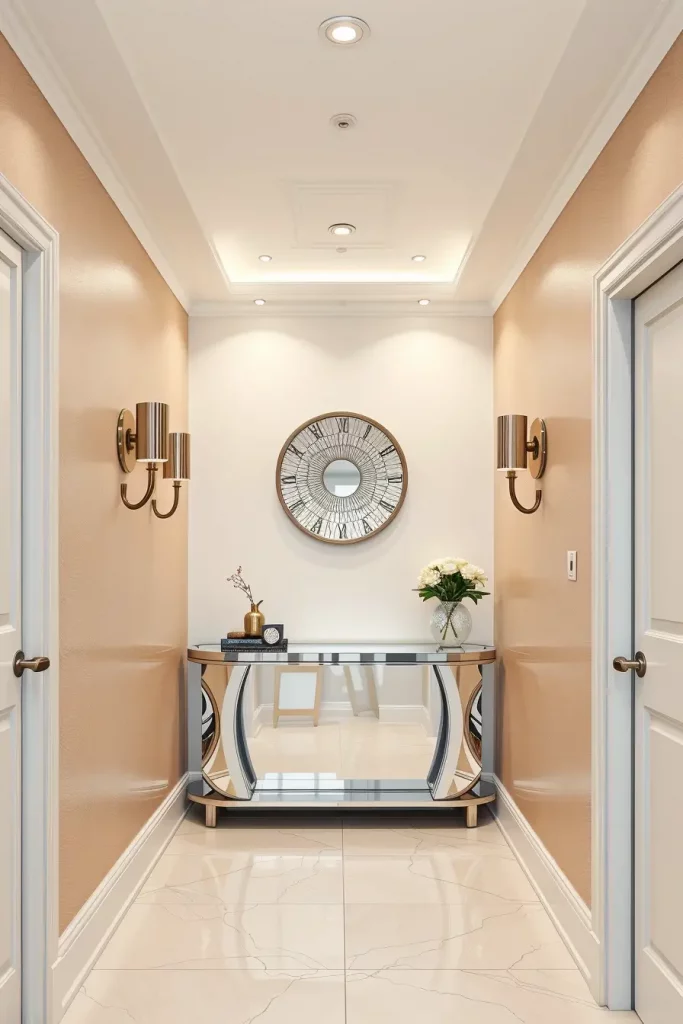
Incidentally, this trick much reduces the shadows for me along dark north-facing hallways. House Beautiful points out that adding a single mirror to a narrow hallway can improve the way it feels.
If you’d like to take it up a notch, try using mirrored tiles or mirrored paneling. Just be sure to add some matte touches to keep the design from being too much for the eye.
Create Hidden Storage Behind Panels Or Art
My favorite way to solve small hallway problems is with disguised storage, as it looks neat and gives you lots of room to store things. Having secret compartments behind wall panels or framed artwork retains your keys, wallets or pet leashes safely, so others won’t be aware of them. It allows you to keep items neatly organized but doesn’t make the space look busy.

I think hinged wall panels with push-latch devices are the best way to carry out this design. If you prefer, get artwork that has space for holding items or opens to give you shelving space. Match the color of your storage to the wall paint in your hallway. For a stronger effect, I add in a narrow console and a little plant to make the look feel more balanced.

I’ve applied this solution to urban apartments and homes with open designs since storage space is often tight here. You’ll find examples in Architectural Digest where hallways include artwork that also functions as a storage place for your essentials, keeping them tucked away professionally.
A good way to improve would be to put in a magnetic board for putting notes and small objects inside the storage space. It changes a hidden spot into a handy place for storing and using family records.
Design A Compact Mudroom Within The Hall
It’s possible to fit a small mudroom in nearly any hallway, even in a little space. It is very helpful when a home lacks a traditional entry area. If you seat a bench in your hall, you can easily drop things here and keep the rest of the house tidy.

Starting with a bench that is narrow and has shoe storage below along with hooks above is perfect. A cubby shelf can hold your baskets and adding a small mirror or decorative art will give your space a sense of purpose. When you have kids or pets, I suggest picking water-resistant materials and washable cushions.
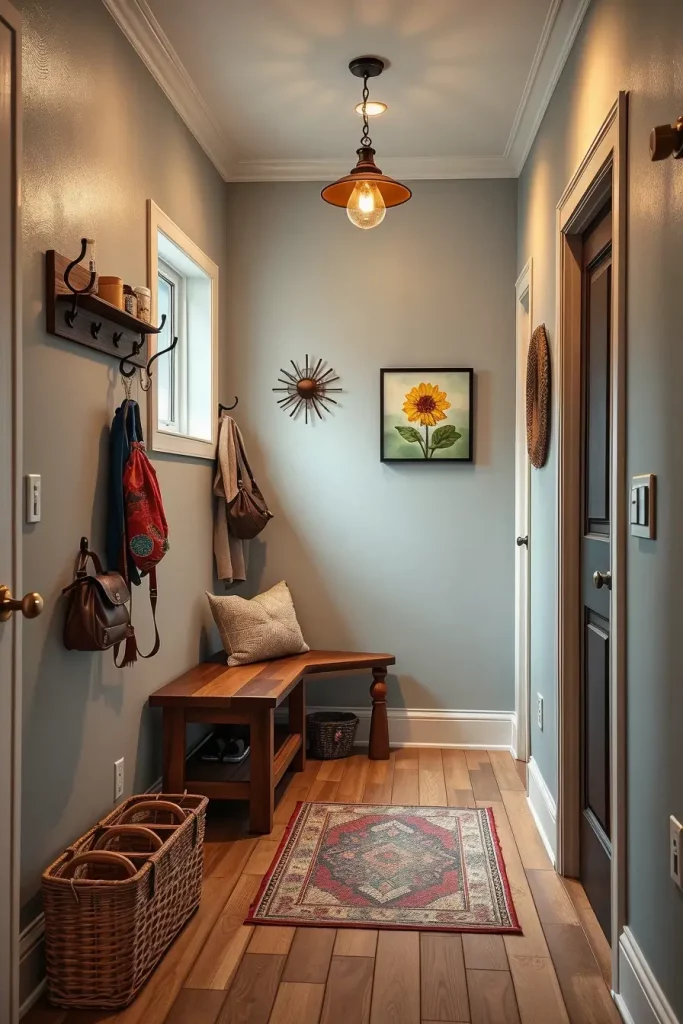
A few years back, I made a mudroom corner in a tiny hallway that snugly fit between a door and cabinet. With shelving above and a simple bench layout, I found that it felt roomy. HGTV says that by using the right organization, small entries can work like useful mudrooms.
For better results, you could include a small mat or pebble tray to sit wet shoes on, this way the space stays clean when the weather is rainy.
Mount Fold-Down Desks For Small Work Zones
As remote work grows, including any extra space in a home can be very useful. I like setting up a folding desk in the hallway so part of the hall doubles as a mini home office. When it is not needed, the TV simply tucks back against the wall.

Try a wall drop-leaf desk or design your own, folding table with brass or matte black hinges. Move in a tiny chair or stool you can keep in a cupboard or closet when not in use. Shelving that attaches to the wall or white boards on the walls are great places to keep your decor or school items.

I’ve placed this setup at the homes of clients who live in small rooms and apartments with very little room. It was Domino Magazine that suggested fold-down furniture for small spaces and I find it makes good sense for so many reasons.
You may want to use a task lamp with a flex-neck pose and a hidden electrical outlet to make this setup better.
Incorporate Smart Home Hooks And Racks
Using technology correctly can make a small hallway feel more special. Try installing smart hooks or racks that know when something is used, remind you about it or work with other parts of your smart home. They let you keep everything organized with some amazing future-focused features.
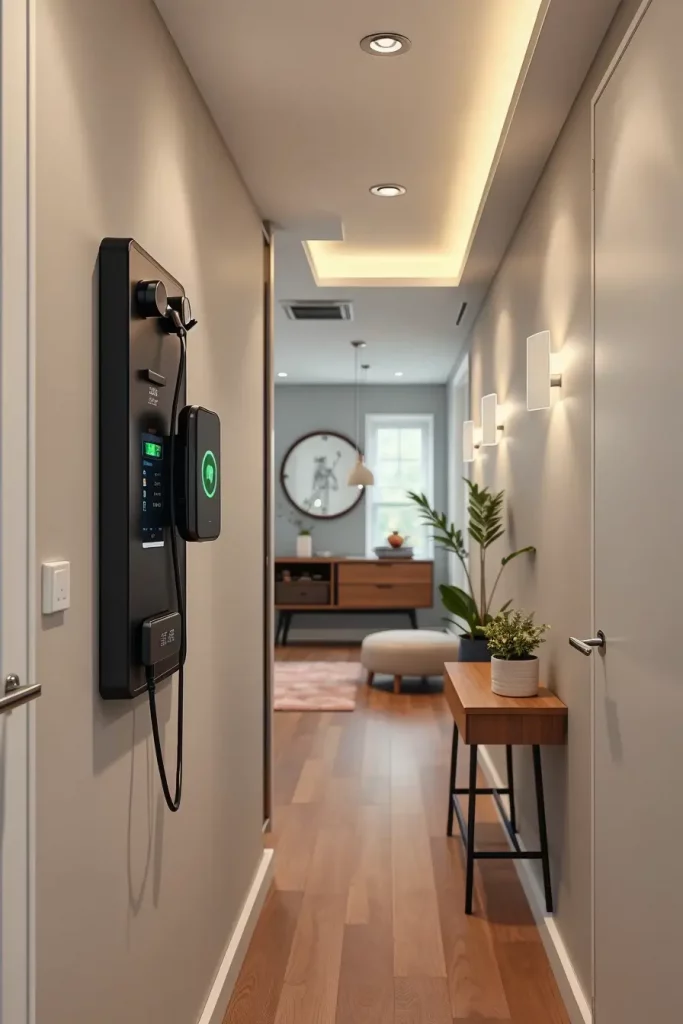
For my purposes, I have a Wi-Fi hook system that lights up when I leave something important behind. Dedicate a rack for your chargers and add motion sensor lights that light up when you are in the garage. You can keep your screen safe by mounting it on a custom floating wood or matte black panel.
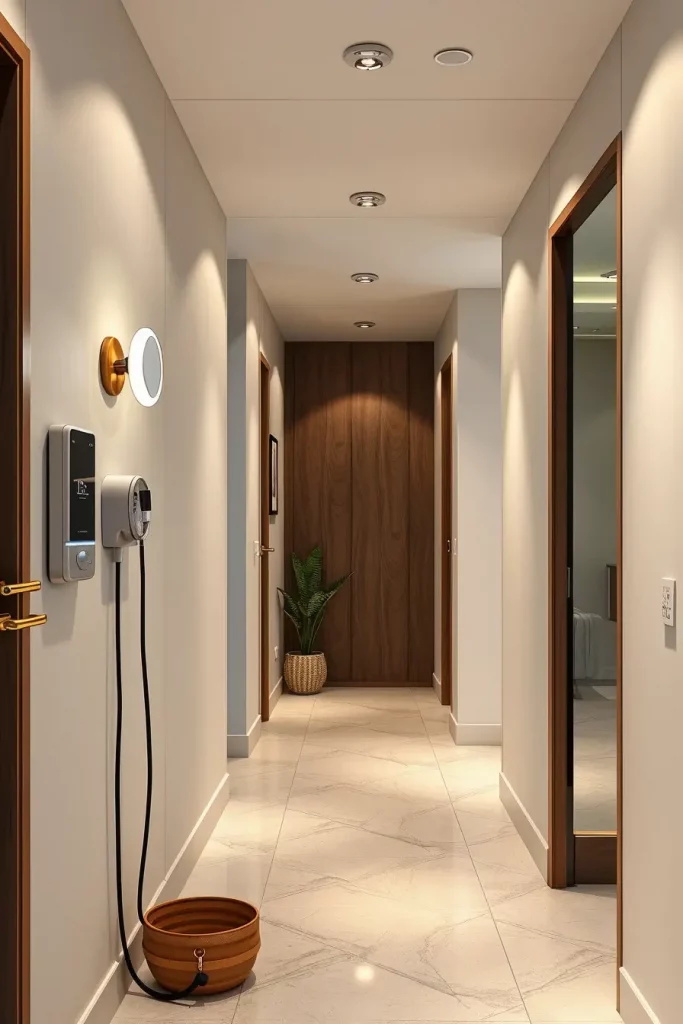
I designed a few extra elements for a tech-aware client who wanted to put more automation at the front entrance. It cut down on morning congestion and added a modern effect to their hallway. Many smart home blogs, like The Verge, believe these tools help make daily tasks easier.
For even better use of this area, you could add voice control for the hallway’s lighting and entryways from the control area.
Use Transparent Furniture For An Airy Feel
When your hallway feels crowded, transparent furniture can still be functional and keep the hall open. Lucite and acrylic creations are popular for me as they add both space for storage or a place to sit while practically blending into the atmosphere.

You might like a clear acrylic table and have keys ready on a small tray or bowl nearby. Using Lucite stools or shelves, bags or items can be stored or shown off perfectly without looking oppressive. Choose wall hooks with little design and an unframed mirror to fit with the look of transparency.
I’ve applied this solution to both coastal homes and apartments with conservative floor space. Illusion of a larger area is possible in a narrow hallway with transparent furniture, Elle Decor asserts.
You can also put LED strips under see-through pieces to make the area feel brighter in the evening.
Build Niche Alcoves For Keys And Decor
Niches on walls are an enduring detail in architecture and help give more function to narrow hallways. I often suggest using small alcoves built onto the wall to store decor, keys or even books. It allows you to keep furniture on the floor by adding height and elegance.

The first thing to do is make 4–6 inch deep niches at the same height as you or someone standing. Add tile, wood or wallpaper inside for a different look. Install strips or small puck lights inside every niche for just a little light. Place keys, a living plant or a sculpture on top of a small tray when designing a corner.
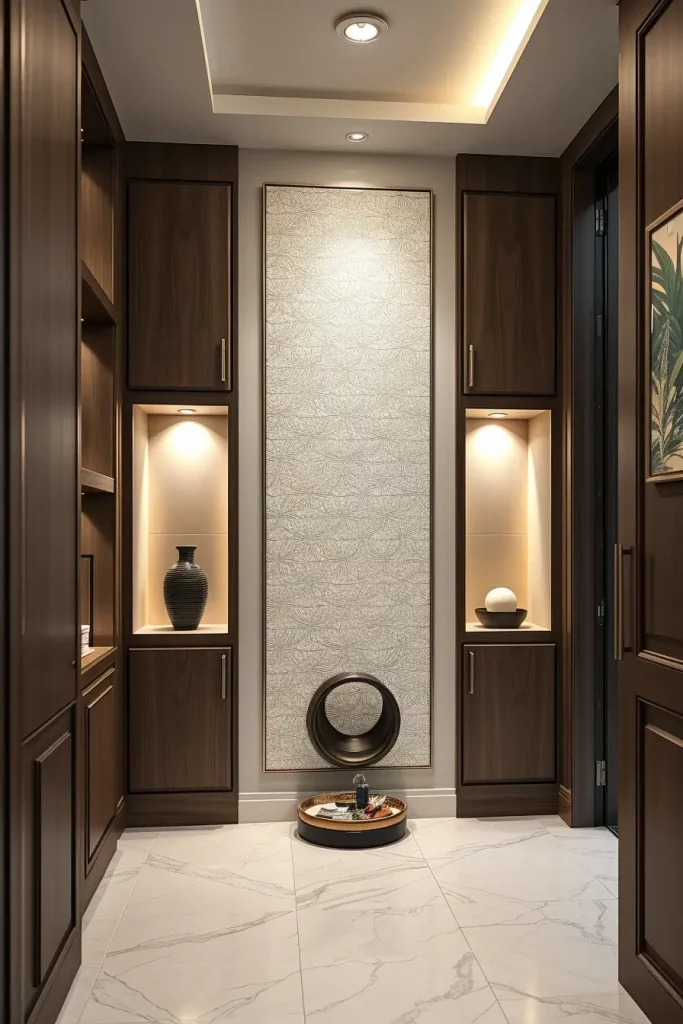
I still do it in new housing projects as well as when I’m renovating houses. Everything works out easier if you handle it while your walls are being replaced or patched. According to Homes & Gardens, built-in alcoves add interesting space without occupying extra room beneath them.
To finish this step, place a lip along the bottom-edge of every niche to help hold things secure—a minor detail that helps a lot.
Use Cohesive Flooring To Create Flow
Flooring has a big impact on how big a hallway appears. Installing matching flooring throughout your house, including in the hallway, unifies the design so it feels well connected. I usually suggest my clients connect the flooring from their adjacent room all the way through the entrance hallway.

My number one suggestion is light wood or stone-style vinyl plank tiles. They are resistant to wear and add a lot of variety to design options. Don’t use area rugs or thresholds that interrupt the flow of the visual space. An easy way is to use one runner rug that matches your floor to create the appearance of a longer room.
In open-plan homes I’ve designed, keeping the type of flooring the same helps create a more contemporary and soothing effect. Real Simple advises that fitting all the flooring to match is an easy way to visually expand a tight plan.
For more of a pixelated look, try to use baseboards or lower wall panels with the same flooring color.
Frame The End Of The Hall With Accent Art
To complete a small hallway, I like to hang bolder accent art at the end. With the visual anchor, the space looks less like a tunnel and gives it a more settled feel. To complement the wall color, I usually choose a piece that offers a small contrast and doesn’t feel overwhelming in the space. You might even notice that the effect makes the hallway seem longer and more attractive while you move along it.
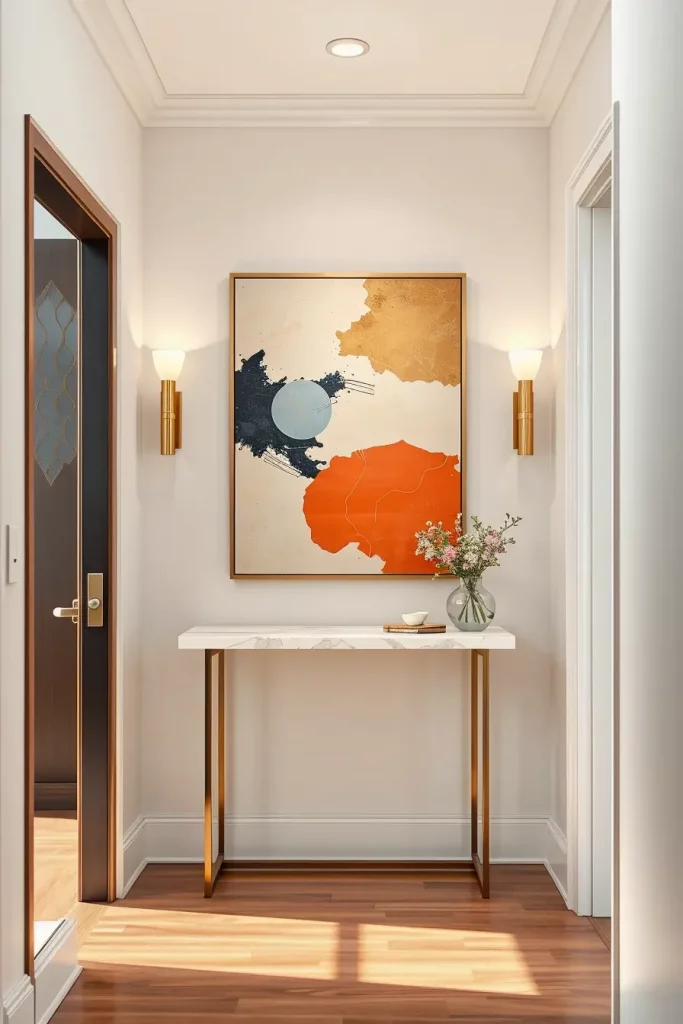
I suggest putting a large canvas, framed picture or textured wall sculpture at the end of your hallway. Pick furniture that matches your overall interior design style, no matter if it’s modern or soft. Picking a slim console table to place below your artwork will make it look more interesting and give you a surface to show off your ceramic bowl or stack of books. Where possible, use narrow wall sconces by each side of the art to add both light and symmetry to your space.
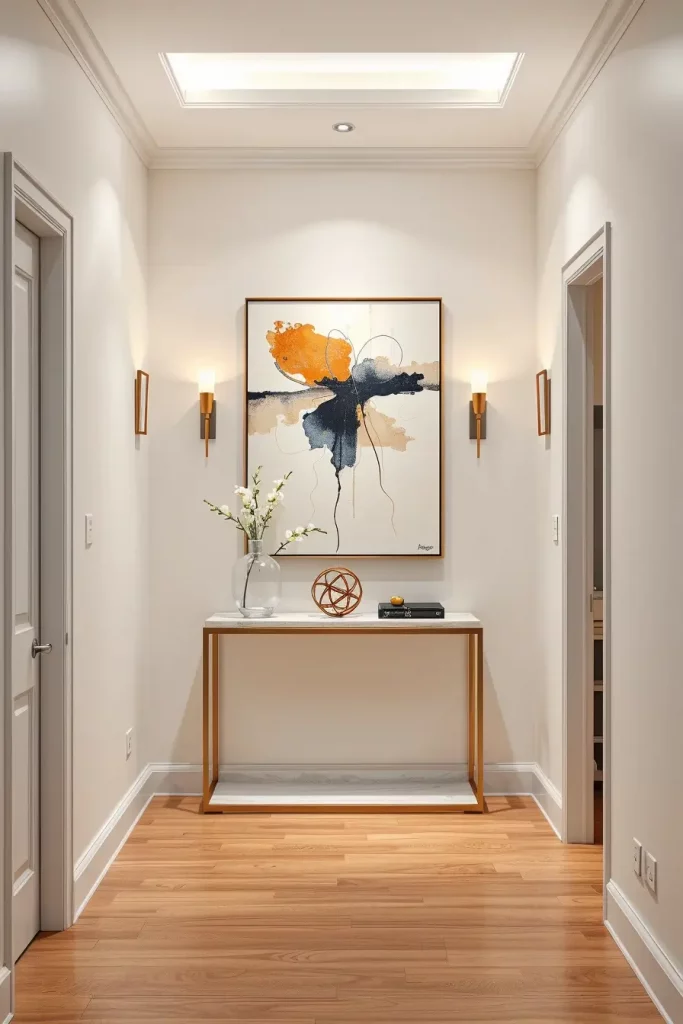
In my opinion, putting artwork at the end of a hallway lifts the energy of the whole space. We selected a soft color, abstract piece and hung it above a marble console as I redesigned the entry of a Manhattan home for a client. Using these items made the room feel classier, but I didn’t have to add big and heavy furniture. Get artwork that draws attention but fits well with the decor of the room.
For those who want their rooms to be stylish and distinct, I’d like to add the idea of oversized photography or creatively designed metal pieces. Placing a small area rug just before the artwork can give the space a better look.
Create Symmetry With Matching Wall Decor
Using symmetry is usually the easiest way to design a narrow and small hallway. When all or nearly all your wall decor is alike, it forms an orderly and balanced appearance. Everything seems more orderly and open in this space which is desirable in cramped corridors.

Framed art, hanging mirrors and sculptural wall lights are all good choices for here. Three to four matching frames arrayed the same way on each side of the hallway are normally my choice. Frames that are matte black with white details give off a clean modern look and gold frames make your glasses more sophisticated. Even if you place your floating shelves symmetrically and fill them with small plants or books, your space will not feel cluttered.

Symmetric designs make a room appear calm and organized. Recently, we added four black-framed artwork pieces along every length of hall in one home and those prints really pulled the design together. As design expert Nate Berkus once said in an interview with Architectural Digest, “Symmetry is a designer’s shortcut to elegance.”
One enhancement would be to add a slender console table beneath the art grouping or to match the wall colors so the whole room stands out. Having LED spotlights above every work would create an even more noticeable atmosphere.
Paint The Ceiling For Added Dimension
Not many people notice the ceiling in a little hallway, but a coat of paint can help the area appear much larger. Try using a rich color or accent shade above the room for contrast, if you are painting the walls a lighter color. Using this technique, the hallway looks larger and more interesting.

You can choose ceiling paint in many ways depending on the look you want in your home. A gorgeous suspended feature can be made using deep navy, muted charcoal or even terracotta. In tighter places, you should choose matte over gloss because it avoids glare. Minimalist pendant lights or recessed ceiling lights are a good match, so the new design doesn’t feel cluttered. You might also coordinate the colors of your art and runner with the ceiling to bring the space together.
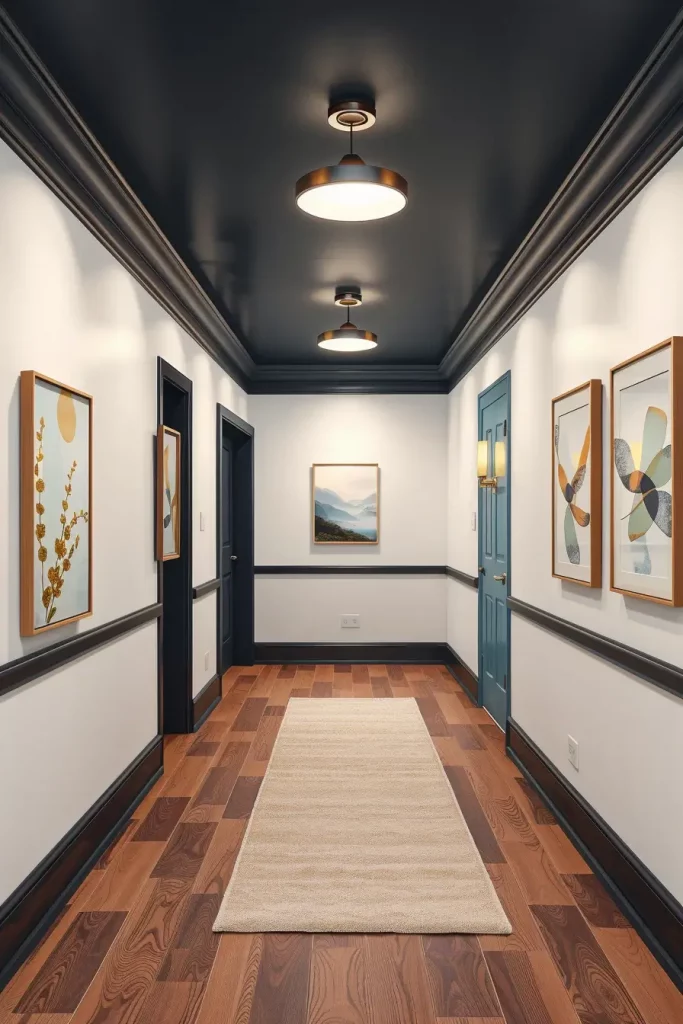
In my opinion, painted ceilings do an excellent job of adding a designer look without using up floor or wall space. When I updated my friend’s narrow hallway, we colored the ceiling green and trimmed it with black molding. The hallway looked longer and more carefully designed. A small ceiling improvement can greatly enhance the look of a space.
This approach can be finished off with some beautiful metallic paint or extra molding as a traditional element. Choosing decor and lighting in the same color as your ceiling will make the room look unified.
Add Seasonal Touches For Personality And Warmth
A small hallway can often seem the same; changing the way you decorate it every season is a simple way to make it fresher and more personal. It’s fun for me to add some references to each season with textiles, colors and accessories that I can replace without needing to change everything.
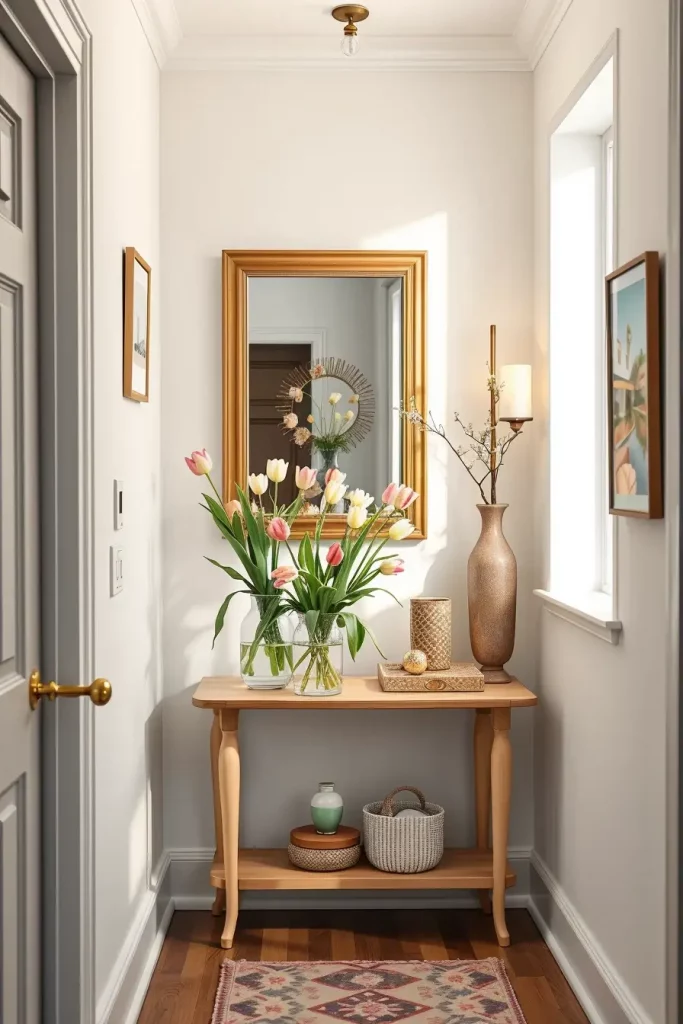
Spring gives me the chance to decorate with tulips and use varying shades of soft pastels as my table runner. You should consider baskets and light linens for your decor during summer. Burnt orange candles, small pumpkins and a cozy lantern are just a few things I use for fall. Snowy weather looks great with soft garlands, candles and a fur bench cushion. Pick a console table, shoe bench or mirror that’s simple and classic so it fits with changing decor.
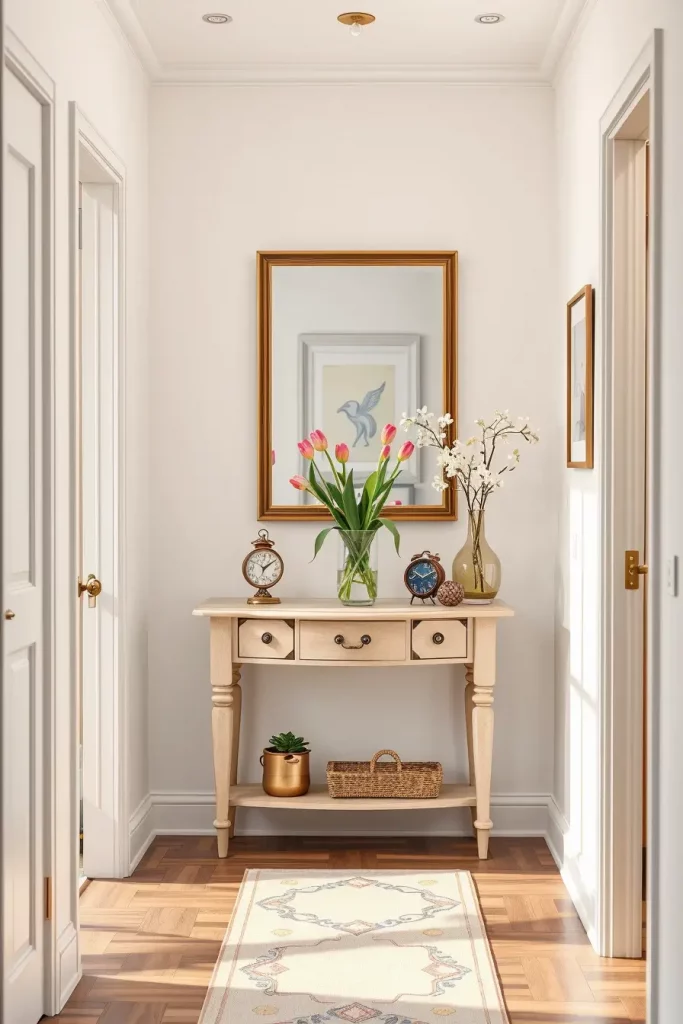
I think this method helps the hallway look exciting but without becoming too busy. I like to hang a wreath or garland on the mirror that mirrors the light in the hall. As the experts at Apartment Therapy advise, having seasonal decor helps your home remain stimulating and attractive, especially if it’s small.
Choosing furniture that can change from regular storage to seasonal decoration would be an improvement. A console table with drawers can keep gloves during winter and a crate can display seasonal summer hats.
Having a small hallway look nice and be practical calls for careful planning and wise use of each area. Framing a work, adding holiday touches or sprinkling color around your room all have an impact. I’d love to hear how you’ve tackled your hallway challenges—share your ideas or ask questions in the comments below!
